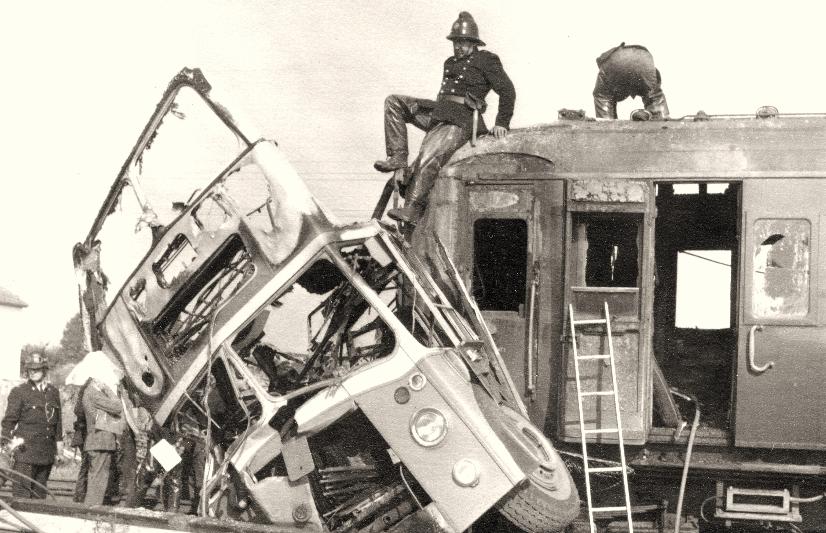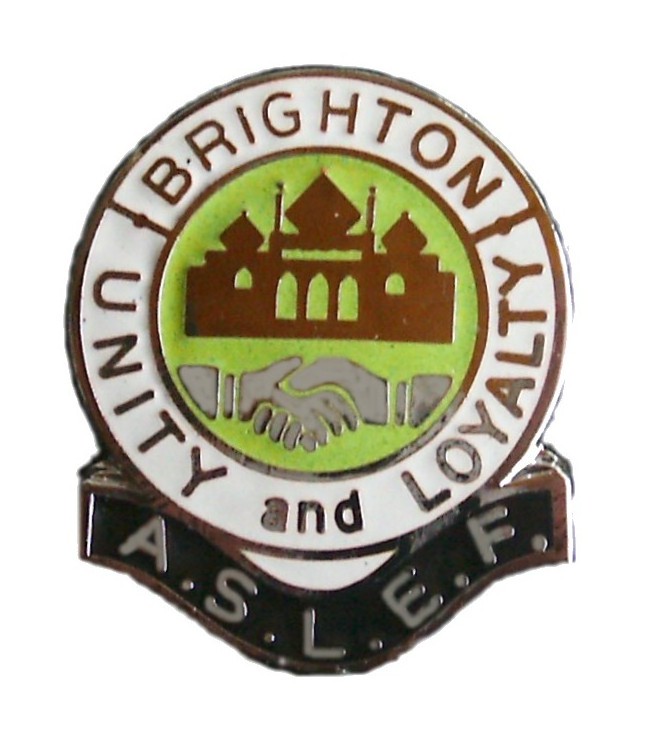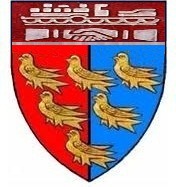ROUNDSTONE LEVEL CROSSING
INVOLVING BRIGHTON MOTORMAN L. PARKER
ON THE 22nd SEPTEMBER 1965
By Colonel W.P. Reed
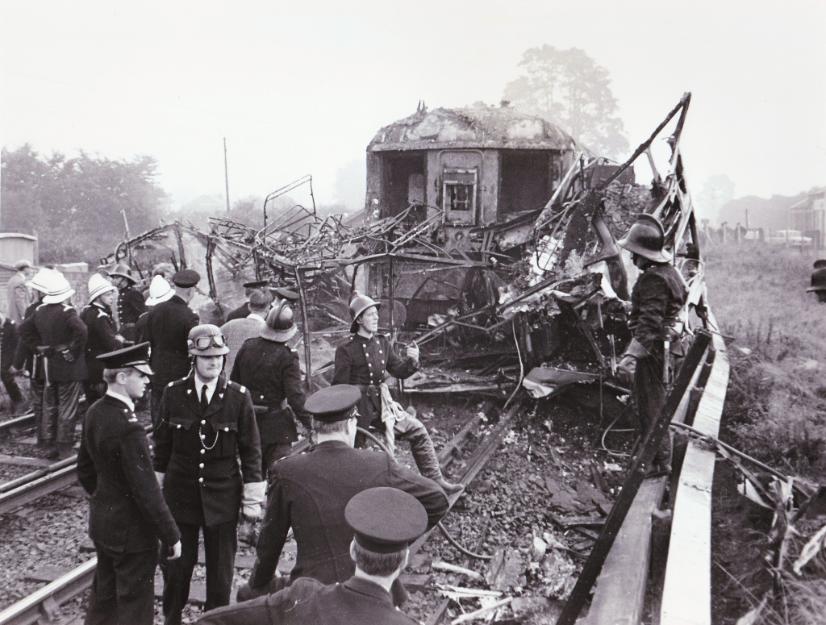
DAVID WARD COLLECTION
Inquiry into the accident that happened at approximately 09.31 hrs on 22nd September 1965 at Roundstone level crossing
near Angmering on the Brighton to Portsmouth line of the Southern Region, British Railways.
In thick fog the 08.47 hrs. Down electric multiple unit 4-coach passenger train ran through the crossing gates which had
been wrongly closed across the line after the train had passed the distant signal for the crossing in the clear position, and
struck a double-decker Southdown motor bus, pushing it along the line for 54 yards before coming to rest. Within a
minute or so the bus caught lire and was quickly consumed. I regret to report that three of the bus passengers were killed
and eight injured. No train passengers were injured and the train driver was able to leave his cab before it was gutted by
the fire which spread to it from the bus.
There was no delay in calling for the emergency services but by the time the fire brigade arrived, within 9 minutes of the
accident, the bus was burning fiercely on its diesel fuel spilt from the broken tank, and it was completely burnt out except
for a small part of the cab. The first coach of the train was severely damaged by fire hut the remainder of the train was not
damaged.
Both lines were blocked by the bus. Breakdown appliances reached the site about 3 hours after the accident and both lines were opened to traffic by 15.18 hrs. Meanwhile a temporary bus service carried railway passengers between stations on either side of the blockage.
DESCRIPTION
The site
Roundstone crossing is on the double track Brighton to Portsmouth line, electrified on the third rail system, between Goring-on-Sea nearly 2 miles away on the Brighton side to the East, (the Up direction) and Angmering 5/8 mile to the West, in the Down direction. It has a pair of gates on either side which swing across the line when open to the road, worked simultaneously by a wheel in the gate box on the Up side of the line and on the Portsmouth side of the road. The gates are kept normally open to the road and are interlocked with protecting signals, the Down home signal, No. 2, being a semaphore 158 yards from the crossing box with the distant signal for Angmering below it, and the Down distant signal No. 3, a 2-aspect colour light 1158 yards from the crossing box. This signal acts also as the outer distant for Angmering. The protecting signals in the Up direction were not connected with the accident but they as follows. The Up home semaphore signal No. 1 is 107 yards from the crossing box and it also serves as the advanced starting signal for Angmering. The Up distant Angmering semaphore signal is therefore also the Up distant crossing signal and it cannot be cleared by the Angmering signalman until the crossing home signal arm is off. Further electrical locking prevents No. 1 lever being fully restored in the frame after having been pulled and thus releasing the gate lock lever to allow the gates to be opened to the road, when the Up advanced starting lever has been pulled in Angmering box.
There are wicket gates which can he locked by the gate keeper but the locking lever is not interlocked with the signals and it is left to the gate keeper to lock the wickets at the last safe moment before a train passes.
The level crossing is at a cross roads. Worthing Road passes over the crossing in a south westerly direction towards Angmering from the Roundstone By-Pass on the north side of the line, and Roundstone Lane reaches the crossing on a southerly route also from the by-pass road, continuing south easterly beyond the crossing as North Lane. There is some residential development in the area interspersed with nursery gardens.
The crossing keeper's instructions are simple. The large gates must be closed and locked across the roadway three minutes before a train is due to pass, and may he opened again as soon as the train has passed unless a train in the other direction is approaching. The box is equipped with 3 position block indicators and repeater block bells for each line and the crossing keeper is also provided with the working timetable of trains. For Up trains he generally closes the gates to the road and pulls his signal levers when Line Clear is shown for a train on the Up line indicator, but for Down trains he generally waits until Train on Line is sent from Goring signalbox. Some variations in this procedure can he carried out to avoid unnecessary delays at the crossing particularly when an Up train is booked to stop at Angmering.
The crossing keeper must observe the trains as they pass and make sure that he has seen the tail lamp before he opens the gates to the road. He must of course also he sure that no train is approaching in the opposite direction. When he opens the gates the block indicator for the line on which the train has just passed will still he showing Train on Line, and in certain circumstances when shunting is carried out at the box ahead must remain in this position for some minutes before the signalman can give the Train Out of Section signal.
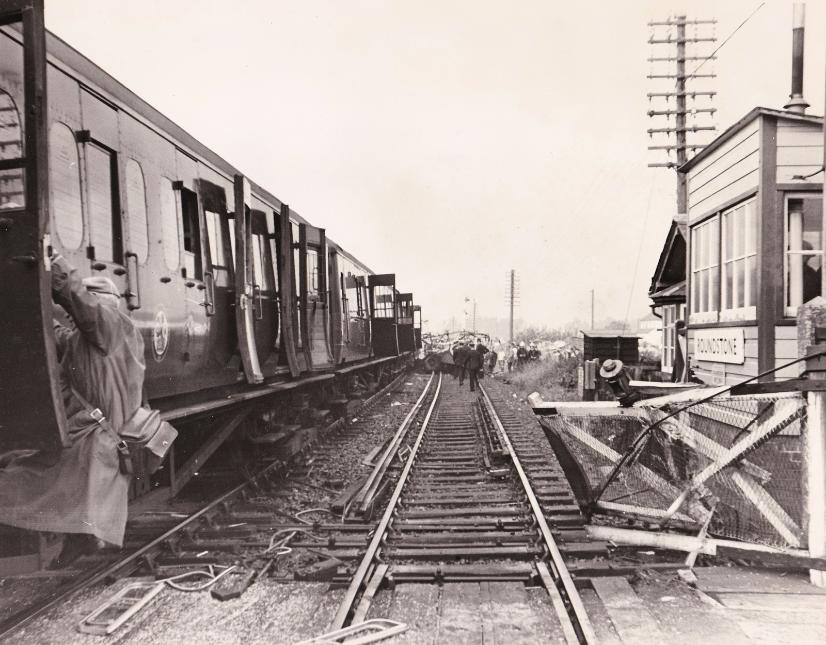
DAVID WARD COLLECTION
The Train and the Bus
The electric train comprised two 2-coach units with a length over buffers of 259 ft., and it weighed 150 tons. It was
equipped with the Westinghouse automatic compressed air brake with braking percentage of 72. The leading coach was
the driving-trailer-composite of "2-Bil" Unit No. 2105, built in 1937. This is a corridor coach but not gangwayed to the
coach in rear, with 8 compartments and a lavatory. There is no access from the corridor to the driver's compartment
which has 2 side doors opening inwards.
The bus was of the normal type used on the Southdown motor services with a double decker body of steel framework and aluminium panels, with seats for 69, on a Leyland, diesel engined chassis. The power operated folding doors on these buses are on the near side just behind the front wheels and there is an emergency door which opens outward at the rear of the bus. There is also a hinged window opening upwards at the rear of the upper deck. The stairs to the upper deck are at the forward end immediately opposite the power doors and behind the driver
SUMMARY OF EVENTS
There was no conflict of evidence as to the cause of this accident. The bare facts are that the crossing keeper became confused
over the state of rail traffic because a number of trains had been running late, saw a queue of road vehicles beginning to form
when the gates had been closed for a little time for the Down train and, listening on the omnibus telephone circuit which
connects a number of signal boxes thought he heard the signalman at Goring tell the signalman at Angmering that the 08.47 hrs
train was not in section. He then put his signals to the "On" position and opened the gates to road traffic. The bus was at the
head of the queue and began to go over the crossing. In the meantime the train had passed the distant signal at clear and was
approaching the crossing at some speed. Because of the fog the driver saw the Home signal at danger at short range only and
could not even reduce speed appreciably before running through the gates and hitting the bus which the train carried ahead for
54 yards, as already stated, before coming to rest.
The train was derailed only at the front bogie, and only the leading coach was damaged, mainly by fire which spread from the
bus. All passengers, and there were only a dozen or so in the first coach out of the 50 in the train, left the train safely before the
fire spread. Fire started in the bus very shortly after the accident and spread rapidly, fed by the spilt diesel fuel from the nearly
full tank. In a few minutes the whole bus was gutted.
The traction electric supply safety equipment worked properly; the circuit breakers for both lines at Angmering sub-station and
Goring track paralleling hut tripped at once, were closed one minute later in accordance with the instructions, tripped again and
were left open thereafter until recovery work required power again.
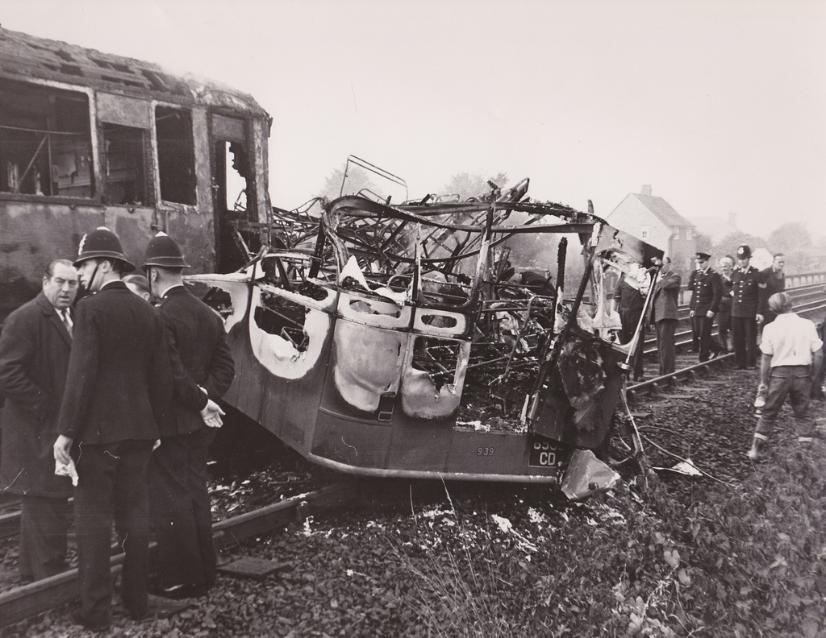
DAVID WARD COLLECTION
EVIDENCE
According to Driver L. Parker, the Down train, which was running about 15 minutes late on account of the fog,
approached the crossing at about 50 to 55 m.p.h. after he had seen the Distant colour light signal at green. He saw the
Home signal at danger at short range because of the fog and applied the brake fully but it had only just begun to take
effect when he ran through the gates and into the side of the bus just after he saw it coming on to the crossing. When the
train stopped with the bus in front of it, Parker climbed through the window of his driving compartment door which had
jammed, saw the bus driver and heard him calling for help, and went to his aid with another railway man who had been
on the train. He then went to protect the Up line. Parker could not remember whether the bus had caught fire before he
went up the line, but both it and the front coach of the train were burning when he returned. He could not estimate how
long he had taken to protect the line.
Guard W . H. Pearson was in the brake van of the second coach. He said that he saw the Roundstone crossing home signal at danger though he had not seen the distant, and applied the brake though he had noted that the driver had also done this. He thought that speed at impact was about 45 m.p.h. When the train stopped he went back to protect in rear of the train. He should have first gone forward in accordance with the Rules to make sure the driver was available to protect the opposite line, where the danger from an oncoming train is more urgent, but could not explain why he had failed to do this.
Mr. B. R. T. Sharp. a civil engineer officer of the Railway was in the 7th compartment of the leading coach. His recollection was that the speed of the train just before the accident was slower than usual, probably not more than 35 m.p.h., but he was not taking particular notice and was reading his paper when the impact came followed by a sheet of flame. It was not a severe check to the train and he was not thrown forward though, as he said, the train shuddered and swayed as it moved grinding to a halt. He agreed that the flash was probably caused by the short circuiting of the conductor rail.
Mr. Sharp got out of his compartment through the outer door and went forward, meeting Driver Parker, and they went
round the bus which was broadside to the train and leaning away from it an angle of about 20°, to the bus driver who was
still in his seat but dazed. As he went he noted that the Up line signals were at danger. The bus engine was running fast
and after they had talked to the driver he recovered enough to switch it off. Mr. Sharp helped the driver out of his cab and
then helped other bus passengers to get out of the bus in which the fire had now caught hold. A ladder was used to get
passengers out from the upper deck through a side window in the far side which had come away from the frame, as
quickly as possible as the fire spread quickly. He was not sure when the fire brigade arrived but it was during these rescue
operations. Mr. Sharp said that his training in first aid helped him in dealing with some of the bus passengers.
Crossing Keeper C. A. Coleman was in charge of Roundstone crossing at the time of the accident. He described what
happened as follows:-
"I commenced duty at 0500 on Wednesday 22nd September at Roundstone crossing. The weather was foggy and the Angmering signalman asked for a fogsignalman and he was called by the acting ganger and took up his post at the Down Inner Distant at 0830 hrs (below the Down home signal for the crossing).
The fog was changeable and became very thick at this time, visibility was 20-25 yards. The 0847 Brighton seemed a long time, and, listening in to a telephone conversation, r heard the signalman at Angmering asking the signalman at Goring if there was anything on the Down line and he replied "no, but one has left West Worthing". I thought from this that I had missed the train on the down line, although my indicator was showing "Train on Line". There was traffic waiting to cross, from the north side and the bus was the first vehicle and several others to follow and 1 replaced the signals and opened the gates. The bus started to move over the crossing, and 1 had barely let go the wheel. when I heard the collision and the bus was carried forward and I could see through the fog that a fire started almost immediately. I telephoned Angmering signalman and I asked him to block both lines and call the ambulances, police and doctors, and the signalman at Goring also came on the 'phone".
Coleman, who had worked at the crossing for the past 2 years said that he was in reasonable health and had no worries on
his mind. He had not had occasion to leave his crossing box for any purpose for some time before the accident and could
in no way account for his lack of thought about testing his assumption that the train had passed before taking the hasty
action which led to the accident. He said that there was no pressure on him from waiting road traffic to open the gates and
that this seldom was so. He understood clearly the method of working the crossing and did not consider it to be difficult
at any time. However, it became clear, in the course of questioning, that the Down train indicator in the box, though of
the more modern three position type in which the indicator shows "Line Blocked", "Line Clear", or "Train on Line”,
could and did remain at "Train on Line" for a few minutes after a Down train had passed if it stopped at Angmering, and
for longer still if the train shunted at Angmering, since the section extends to Angmering box on the Portsmouth side of
the station. The indicator was therefore of value in showing the keeper when a train was signalled, and when it was
approaching, hut not in showing him that the train had passed, until it was returned to the "Line Blocked" position by
Angmering signalman, which might infrequently be as much as 10 minutes after the train had passed.
The other two crossing keepers for this three shift crossing, W. S. Ayling and I. Key, confirmed this situation but neither of them found any difficulty from it since it was an essential though simple part of their duty to watch the train pass and see the tail lamp before opening the gate.
Signalman C. W. S. Birchfield of Angmering box and K. L. Bond of Goring box described the movement of trains during that morning. There had been a little delay to a number of trains on account of the fog but they were not in difficulties and their train passing messages were exchanged in normal fashion. They did not have a telephone conversation about the 0847 hrs train though they did speak, about 20 minutes before the accident took place, about a Down vans train which was moved from the Down line at Angmering to the Up siding, and about a light shunting engine which was to follow that train. Both signalmen did what was necessary in reporting the accident and arranging for emergency services, but neither sent the Obstruction Danger signal to the other which they should have done.
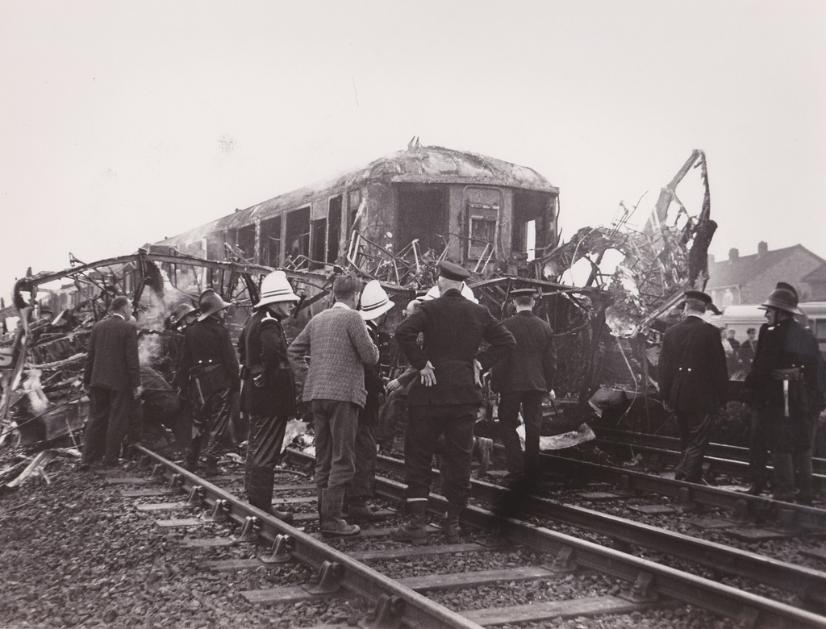
DAVID WARD COLLECTION
CONCLUSION AND REMARKS
The cause of this accident was clear. Crossing Keeper C. A. Coleman made an assumption that he had missed the passage
of the 0847 hrs train, and without testing it or giving further thought to his actions put back the signal levers and opened
the gates to road traffic. The train had passed the distant signal at clear before the lever was put back, and because of the
fog the driver was unable to see the Home signal at danger in time to slow down, or even to sound a warning to road
traffic which had moved on to the crossing. The crossing keeper could have tested his assumption simply by ringing
either of the signalmen, and even without doing this he could have prevented the accident by waiting a minute after
putting back the signals before opening the gates. This would have enabled him to make sure that no train was
approaching at speed having passed the distant signal before it was put back to caution.
Crossing keepers would have a more positive indication of the movement of trains if there was an automatic cancelling
device on the indicator to restore it to "Line Blocked" as soon as the train had passed. This might be of value on a four-
track route hut l do not ask for it to be added to the controls on two-track routes such as this. It is an essential part of the
crossing keeper's duties to watch trains pass and it is a simple duty to carry out where there are only two tracks.
I think that Mr. Sharp's estimate of 35 m.p.h. for speed of impact was probably more correct than the higher one of Driver Parker. From 35 m.p.h. the retardation would have been ¼ g which is quite high and the time taken to stop in 54 yards would have been 6 to 7 seconds.
I discussed the fierce burning of the bus with the officers of the Southdown Motor Services to get their views on whether
the finish of the interior had been in any way contributory. They informed me that the foam rubber of the seating did burn
strongly once it was thoroughly heated hut that the decorative finish of the interior was not of highly inflammable paint or
varnish. It was not clear how the fire started, though the fast running engine may have caused sparks through broken
dynamo leads, or leads from the battery may have caused sparks, but once the fire started, spilt fuel from the damaged
tank which was on the side of the bus hit by the train, would have provided the combustible material to consume the bus
by fire.
Discussions about the fire in the coach with the Railway officers and 'tests made afterwards also showed that the
materials used in the finish of the coach interior were not highly combustible. The unit had been last painted in 1959 and
varnished in 1963; the materials used had been to the standard B.R. specification. The severe charring of the interior of
this coach must have been caused by the intense heat from the burning bus and the free movement of air allowed by the
open windows of the coach. It is of interest that one compartment of which the corridor door and windows remained
closed, was hardly affected at all.
RECOMMENDATION
This kind of accident would not have happened at an automatic half barrier crossing where the instruction to stop to road traffic is given automatically by the approaching train when it comes on to a track circuit. This illuminates the twin red flashing light road signals (a statutory stop signal) at the crossing and then lowers the half barriers, before the train arrives. The timing of the sequence is designed to give proper notice to stop without causing road accidents, and the length of the track circuit is calculated so that the fastest train will pass shortly after the barriers are down so as to avoid unnecessary delays and to reduce the temptation to disobey the signals. The display of flashing lights and the timing of events is equally effective for pedestrian safety.
This system eliminates the possibility of error by the train driver or crossing attendant and relies for its safety on simple
obedience by the road user. A number of such crossings have been installed on British Railways with very satisfactory
results and the use of this equipment is to be extended. Though an automatic half barrier layout at Roundstone will not be
easy because of the cross roads at the crossing, I hope that one can be designed to enable the equipment to be installed
here. From the railway point of view, the crossing is most suitable for automatic half barriers.
